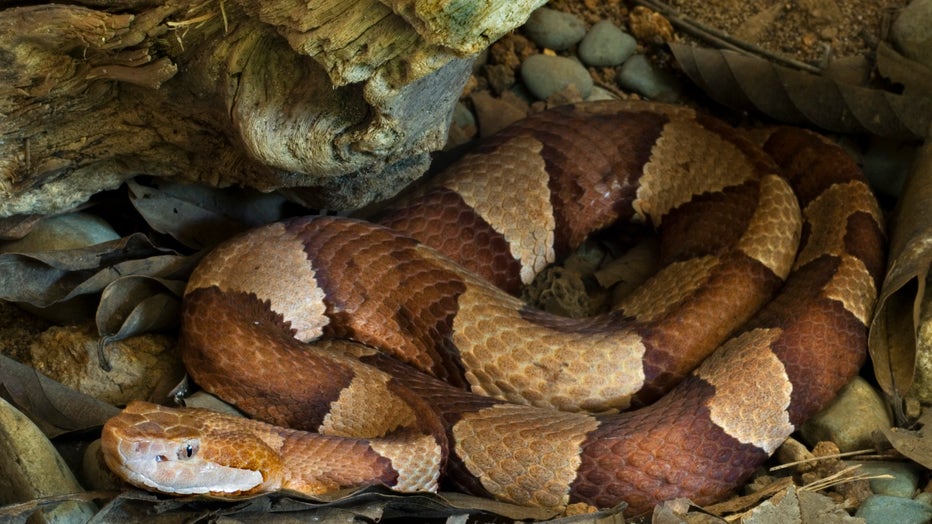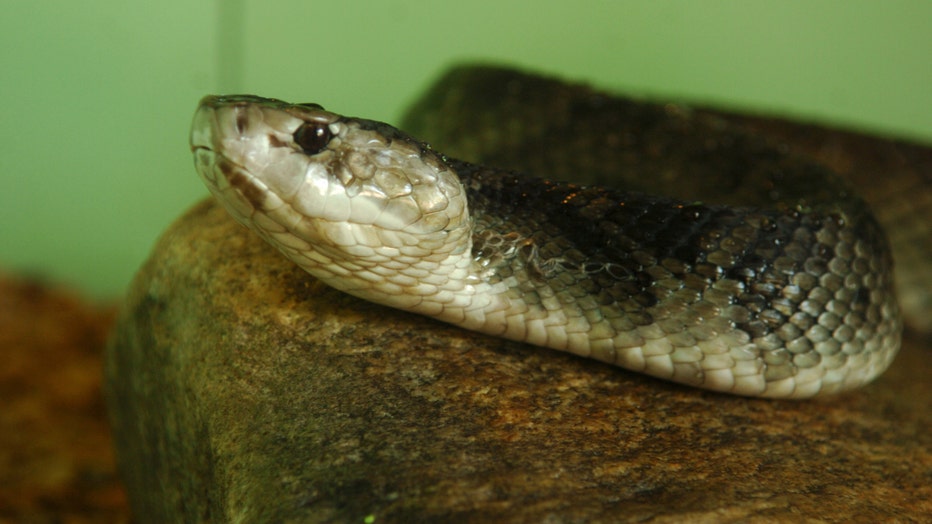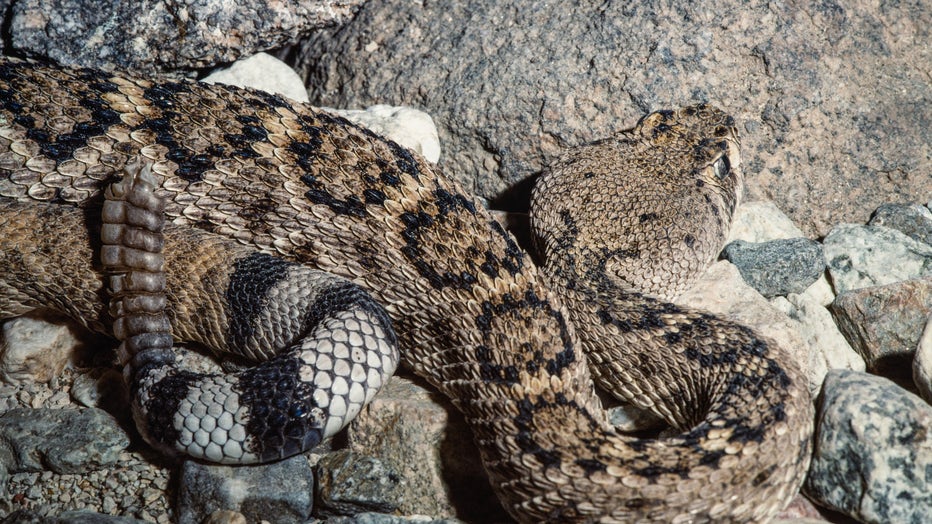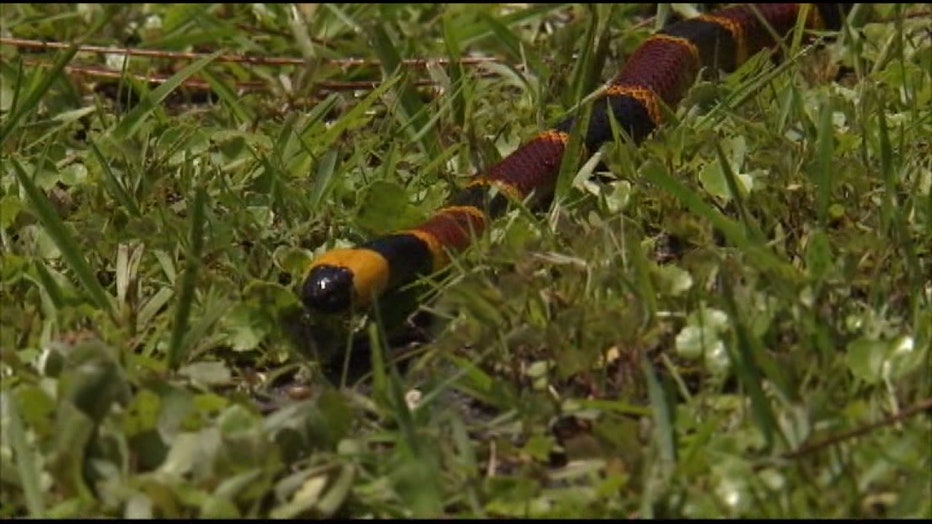Venomous snakes in Central Texas: What you need to know
AUSTIN, Texas - Summer is peak snake season here in Central Texas, here are some things to know about the venomous snakes in our area so you can watch out for snakes while out hiking in our many parks, greenbelts and trails.
What snakes are venomous in Central Texas?
According to Texas Parks & Wildlife, there are two kinds of venomous snakes in Texas: coral snakes and pit vipers.
ATCEMS says that most venomous snakes in Central Texas are pit vipers, such as copperheads, cottonmouths or water moccasins, and rattlesnakes. These are called pit vipers because they have a pit near each nostril which is highly sensitive to heat and helps the snake in locating warm-blooded prey. The Texas A&M Agrilife Extension Service says that pit vipers also have venom glands on the sides of their heads, giving the head a triangular appearance.
Copperheads
Copperhead snakes have bands of gray and/or brown with a copper-colored head, making it easy for them to blend in with leaf-covered forest floors. Copperheads bite rather than strike and most bites occur when a snake is accidentally picked up, sat or laid on because of how easy it camouflages.

Broad-banded copperhead / Texas copperhead (Agkistrodon contortrix laticinctus ) curled up under tree trunk. (Photo by: Arterra/Universal Images Group via Getty Images)
Texas A&M Agrilife says that the body shape of copperheads is similar to rattlesnakes, but they lack rattles and have thicker bodies. Copperheads are typically found in forested areas, including wooded suburbs and are found across most of Texas, except for far south Texas, the panhandle, and the northwest portion of the Trans-Pecos.
Cottonmouths
The cottonmouth, or water moccasin, rarely strays far from water and can be found in marshes, swamps, ponds, lakes, ditches, and canals in East and Central Texas and along the Gulf coast. When threatened, it will open its mouth to show its fangs. The inside of its mouth is white, reminiscent of cotton, hence the name cottonmouth.

Pictured is a cottonmouth or water moccasin. (Photo by Ed Sackett/Orlando Sentinel/Tribune News Service via Getty Images)
Texas Parks & Wildlife says cottonmouths can be very defensive and sometimes aggressive and can bite underwater.
Rattlesnakes
There are ten kinds of rattlesnakes that live across Texas, says Texas Parks & Wildlife. Rattlesnakes will usually vibrate the end of its tail, making a rattling sound before striking, but if they are totally surprised, they may strike before rattling. Most of the rattlesnakes are active at night, when they hunt for prey such as mice, rats and rabbits.

The Western Diamondback Rattlesnake or Texas Diamondback is a venomous snake found in the southwestern U.S. and northern Mexico. ((Photo by: Jon G. Fuller/VWPics/Universal Images Group via Getty Images))
The Western Diamondback, the blacktail rattlesnake, timber rattlesnake, and the western massasauga are the types typically found in Central Texas, says Texas Parks & Wildlife.
Coral snakes
Texas Parks & Wildlife says only one species of coral snake is native to Texas and is shy and rarely seen. The coral snake has a small mouth and head and a slender body with alternating rings of bright red, yellow and black, and is usually not aggressive. Its bites are dangerous with extremely potent venom, but very rare.

Texas coral snakes are found throughout most of the state except the panhandle and Trans-Pecos, says Texas A&M Agrilife. They are usually found in forested habitats, including wooded suburbs.
The rhyme "red and yellow, kill a fellow" can help hikers remember that the coral snake's red and yellow colors touch, while the harmless milk snake has red rings touching black.
What can I do to try and prevent getting bitten?
ATCEMS offers the following tips to prevent snake bites:
- Be aware that snakes may be in/around water, tall grass, fallen logs, outcroppings, hiding under debris or other objects or in animal burrows
- If you see a snake, freeze, back away slowly and don't touch it
- Snakes will usually escape or retreat if given the opportunity
- Do not pick up or try to trap a snake
- Never handle a venomous snake, not even a dead one or its decapitated head
- Heavy footwear, snake-proof trousers, leggings or boots will help reduce the risk of bites
Texas Parks & Wildlife says that snakes will usually avoid people, but will definitely bite if stepped on or if they feel trapped. Most bites will happen around the ankle, and about 99% of all bites happen below the knee, so Texas Parks & Wildlife advises watching carefully where you step and to wear boots in tall grass.
The Texas Agrilife Extension also recommends using a stick or long-handled tool to move boards or logs rather than reaching underneath.
"Best thing you can do is leave it alone—leave it alone, they'll leave you alone. They're wild animals and they don't want to have interaction with people. Given the opportunity, they will try and get away from people. I'm still waiting for a snake to chase me, and I've been chasing snakes for 60 years," said Tim Cole, owner of Austin Reptile Service.

What to know about venomous snakes in Central Texas
ATCEMS says it's peak snake season in Central Texas, so here are some things to know about the venomous snakes in our area.
For dog owners, it’s especially important to protect them from snakes. There is a rattlesnake vaccine for dogs, but right now there’s controversy about how effective it is.
That’s why Austin Pets Alive! says prevention is key:
- Don’t let dogs off-leash, especially in areas where they may not be able to see where they’re stepping
- Practice recall with your dog: make sure they’re good at coming when they’re called
- Don’t let your dog play with any snakes, even harmless ones.
If your dog is bitten, you should take action right away.
"I would go to the emergency center right away. They probably will need anti-venom and the most of the emergency centers will have that on hand. So I would try and get it as quickly as you can for your dog. Some dogs can survive without it, but it's a really painful process," said Laura Thomas, Dog Care Manager with Austin Pets Alive!
What do I do if I am bitten by a snake?
ATCEMS says first and foremost if you're bitten by a snake to remain calm and seek medical attention as soon as possible by calling 911 or local EMS. Antivenom is the best treatment for snake bites and the sooner it can be applied, the sooner irreversible damage can be stopped.
It is also advised to take a photo of the snake from a safe distance if possible to help with proper identification.
"The more angry and excited you are, your heart rate goes up, blood circulation is increased, and that can circulate the venom a little bit more. Call 9-1-1 because there are measures, obviously, we can get you to the appropriate level of care a little bit quicker," said Capt. Darren Noak with Austin-Travis County EMS.
While waiting for EMS, you can also do the following for first aid:
- If bitten by a pit viper, lay or sit down with the bitten limb elevated at about 60 degrees
- If bitten by a coral snake, maintain the bitten limb at level with the heart
- Remove all rings and watches before swelling starts
- Wash the bite in soap and water and cover it with a dry dressing
- Mark the leading edge of any tenderness or swelling on the skin and write the time alongside it
What should I not do if I am bitten by a snake?
ATCEMS also says there are things you should not do if you're bitten by a snake:
- Do not drive yourself to the hospital, as people with snakebites can become dizzy or pass out
- Do not wait for symptoms to appear, seek medical attention right away
- Do not apply a tourniquet
- Do not slash or cut the wound in any way
- Do not try and suck out the venom
- Do not apply ice or immerse the wound in water
- Do not take pain relievers, such as aspirin, ibuprofen or naproxen
- Do not apply electric shock or folk remedies
Click here for Austin Reptile Service’s guide to venomous snakes in our area. Click here for the guide to the non-venomous snakes.

